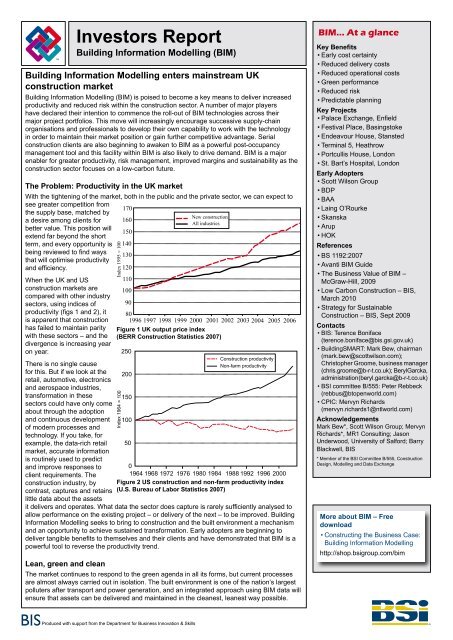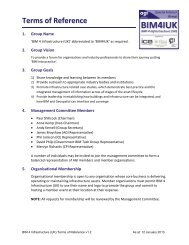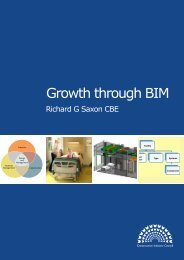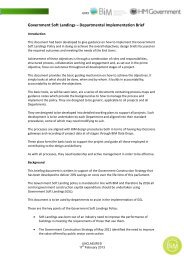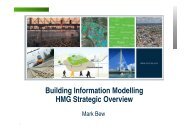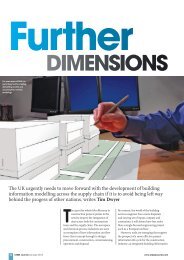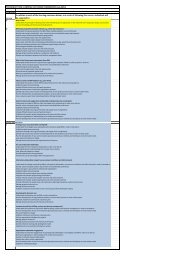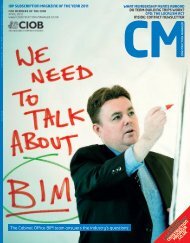Investors Report - BIM Task Group
Investors Report - BIM Task Group
Investors Report - BIM Task Group
You also want an ePaper? Increase the reach of your titles
YUMPU automatically turns print PDFs into web optimized ePapers that Google loves.
Building Information Modelling enters mainstream UK<br />
construction market<br />
Building Information Modelling (<strong>BIM</strong>) is poised to become a key means to deliver increased<br />
productivity and reduced risk within the construction sector. A number of major players<br />
have declared their intention to commence the roll-out of <strong>BIM</strong> technologies across their<br />
major project portfolios. This move will increasingly encourage successive supply-chain<br />
organisations and professionals to develop their own capability to work with the technology<br />
in order to maintain their market position or gain further competitive advantage. Serial<br />
construction clients are also beginning to awaken to <strong>BIM</strong> as a powerful post-occupancy<br />
management tool and this facility within <strong>BIM</strong> is also likely to drive demand. <strong>BIM</strong> is a major<br />
enabler for greater productivity, risk management, improved margins and sustainability as the<br />
construction sector focuses on a low-carbon future.<br />
The Problem: Productivity in the UK market<br />
With the tightening of the market, both in the public and the private sector, we can expect to<br />
see greater competition from<br />
170<br />
the supply base, matched by<br />
New construction<br />
a desire among clients for 160<br />
All industries<br />
better value. This position will<br />
150<br />
extend far beyond the short<br />
term, and every opportunity is 140<br />
being reviewed to find ways 130<br />
that will optimise productivity<br />
and efficiency.<br />
120<br />
When the UK and US<br />
construction markets are<br />
compared with other industry<br />
sectors, using indices of<br />
productivity (figs 1 and 2), it<br />
is apparent that construction<br />
has failed to maintain parity<br />
with these sectors – and the<br />
divergence is increasing year<br />
on year.<br />
There is no single cause<br />
for this. But if we look at the<br />
retail, automotive, electronics<br />
and aerospace industries,<br />
transformation in these<br />
sectors could have only come<br />
about through the adoption<br />
and continuous development<br />
of modern processes and<br />
technology. If you take, for<br />
example, the data-rich retail<br />
market, accurate information<br />
is routinely used to predict<br />
and improve responses to<br />
client requirements. The<br />
construction industry, by<br />
contrast, captures and retains<br />
little data about the assets<br />
<strong>Investors</strong> <strong>Report</strong><br />
Building Information Modelling (<strong>BIM</strong>)<br />
Index 1995 = 100<br />
Index 1964 = 100<br />
110<br />
100<br />
90<br />
80<br />
1996 1997 1998 1999 2000 2001 2002 2003 2004 2005 2006<br />
Figure 1 UK output price index<br />
(BERR Construction Statistics 2007)<br />
250<br />
200<br />
150<br />
100<br />
50<br />
Construction productivity<br />
Non-farm productivity<br />
0<br />
1964 1968 1972 1976 1980 1984 1988 1992 1996 2000<br />
Figure 2 US construction and non-farm productivity index<br />
(U.S. Bureau of Labor Statistics 2007)<br />
it delivers and operates. What data the sector does capture is rarely sufficiently analysed to<br />
allow performance on the existing project – or delivery of the next – to be improved. Building<br />
Information Modelling seeks to bring to construction and the built environment a mechanism<br />
and an opportunity to achieve sustained transformation. Early adopters are beginning to<br />
deliver tangible benefits to themselves and their clients and have demonstrated that <strong>BIM</strong> is a<br />
powerful tool to reverse the productivity trend.<br />
Lean, green and clean<br />
The market continues to respond to the green agenda in all its forms, but current processes<br />
are almost always carried out in isolation. The built environment is one of the nation’s largest<br />
polluters after transport and power generation, and an integrated approach using <strong>BIM</strong> data will<br />
ensure that assets can be delivered and maintained in the cleanest, leanest way possible.<br />
<strong>BIM</strong>… At a glance<br />
Key Benefits<br />
• Early cost certainty<br />
• Reduced delivery costs<br />
• Reduced operational costs<br />
• Green performance<br />
• Reduced risk<br />
• Predictable planning<br />
Key Projects<br />
• Palace Exchange, Enfield<br />
• Festival Place, Basingstoke<br />
• Endeavour House, Stansted<br />
• Terminal 5, Heathrow<br />
• Portcullis House, London<br />
• St. Bart’s Hospital, London<br />
Early Adopters<br />
• Scott Wilson <strong>Group</strong><br />
• BDP<br />
• BAA<br />
• Laing O’Rourke<br />
• Skanska<br />
• Arup<br />
• HOK<br />
References<br />
• BS 1192:2007<br />
• Avanti <strong>BIM</strong> Guide<br />
• The Business Value of <strong>BIM</strong> –<br />
McGraw-Hill, 2009<br />
• Low Carbon Construction – BIS,<br />
March 2010<br />
• Strategy for Sustainable<br />
Construction – BIS, Sept 2009<br />
Contacts<br />
• BIS: Terence Boniface<br />
(terence.boniface@bis.gsi.gov.uk)<br />
• BuildingSMART: Mark Bew, chairman<br />
(mark.bew@scottwilson.com);<br />
Christopher Groome, business manager<br />
(chris.groome@b-r-t.co.uk); Beryl Garcka,<br />
administration (beryl.garcka@b-r-t.co.uk)<br />
• BSI committee B/555: Peter Rebbeck<br />
(rebbus@btopenworld.com)<br />
• CPIC: Mervyn Richards<br />
(mervyn.richards1@ntlworld.com)<br />
Acknowledgements<br />
Mark Bew*, Scott Wilson <strong>Group</strong>; Mervyn<br />
Richards*, MR1 Consulting; Jason<br />
Underwood, University of Salford; Barry<br />
Blackwell, BIS<br />
* Member of the BSI Committee B/555, Construction<br />
Design, Modelling and Data Exchange<br />
More about <strong>BIM</strong> – Free<br />
download<br />
• Constructing the Business Case:<br />
Building Information Modelling<br />
http://shop.bsigroup.com/bim<br />
Produced with support from the Department for Business Innovation & Skills
What is Building Information Modelling?<br />
Building Information Modelling (<strong>BIM</strong>) is the process of generating and<br />
managing information about a building during its entire life cycle.<br />
<strong>BIM</strong> is a suite of technologies and processes that integrate to form the<br />
‘system’ at the heart of which is a component-based 3D representation of each<br />
building element; this supersedes traditional design tools currently in use. Each<br />
component is generated from a product library and has embedded information<br />
about the product and its placement, material, specification, fire rating, U-value,<br />
fittings, finishes, costs, ‘carbon content’ and any special requirements, which is<br />
stored in the system. As the design progresses, so the integrated information<br />
becomes more valuable. Sophisticated applications and clash detection can<br />
rapidly identify issues which can be designed out at an early stage. <strong>BIM</strong> could be<br />
mistaken for a simple design tool but this overlooks the fact that it is the way the<br />
system generates interfaces to and uses information from other systems which<br />
is fundamental to the delivery of greater benefits. These benefits accrue to the<br />
whole supply chain through the collaborative, integrated use of <strong>BIM</strong>.<br />
There are parallels between <strong>BIM</strong> and the EPOS (electronic point of sale) and<br />
ERP (enterprise resource planning) systems ubiquitously found in the retail<br />
sector. There is a clear interface between <strong>BIM</strong> and organisational corporate<br />
© Scott Wilson <strong>Group</strong> 2010<br />
systems – including those dealing with procurement, finance and supply chain performance. As the graphic (above right) shows, <strong>BIM</strong> sits<br />
at the heart of an information web which includes systems directly attributed to design, construction and those business support systems<br />
which are used to ensure overall efficient asset and corporate performance.<br />
Why Should I Consider <strong>BIM</strong>?<br />
There is some published commercial research<br />
and data gathered from case studies. The<br />
case studies mentioned as ‘key projects’ in<br />
the right-hand panel on the previous page<br />
have been summarised in the graph (right).<br />
The red plot indicates the average saving of<br />
projects available for measurement to date,<br />
with the green plot indicating potential benefits<br />
expected by the early adopter community.<br />
Most of the data covered the design, preconstruction<br />
and construction stages. There<br />
were clear wins in design understanding,<br />
spatial and design co-ordination and 4D<br />
programme integration. Benefits post<br />
construction have still to be measured.<br />
Clearly, this demonstrates considerable<br />
upside potential, especially when the<br />
processes are applied to the entire project<br />
life cycle through to facilities management.<br />
These benefits increase further year on year,<br />
as around 80% of an asset’s cost is incurred<br />
during its operational phase. Whilst our case<br />
studies have focused on monetary benefits,<br />
studies are ongoing to establish similar<br />
relationships for carbon.<br />
Preparation<br />
Design<br />
Pre-construction<br />
Construction<br />
Use<br />
A<br />
B<br />
C<br />
D<br />
E<br />
F<br />
G<br />
H<br />
J<br />
K<br />
L<br />
Appraisal<br />
Design brief<br />
Concept<br />
Design<br />
development<br />
Technical<br />
design<br />
Product<br />
information<br />
Tender<br />
documentation<br />
Tender<br />
action<br />
Mobilisation<br />
Construction<br />
to practical<br />
completion<br />
Post practical<br />
completion<br />
% Benefit 20 40 60 80<br />
There is limited data other than empirical to indicate tangible savings at the early<br />
stages of projects in the UK to date. It is expected that the majority of future savings<br />
will be made through the use of data available from the result of feeding performance<br />
information into the project libraries and enabling better informed early design<br />
All case study projects identified improvements at the actual delivery of design<br />
stages, with understanding and spatial co-ordination the two clear big wins<br />
The data sample available for us to draw conclusions shows reductions of 8–18% on<br />
design fees in the main three design disciplines<br />
Measured benefit<br />
Upside potential<br />
There are identifiable savings made on the co-ordination of trade contractor design<br />
information (especially co-ordination and workshop design)<br />
The sample is consistent and shows figures of 8–<br />
10% of construction cost<br />
Key savings here are around the delivery of co-ordinated clear information to the<br />
construction team. The use of 4D programme integration offers clear understanding<br />
to package teams both in terms of the build, but also work-face co-ordination,<br />
productivity and health and safety<br />
The case study sample consistently shows figures of 8–<br />
10% of construction cost<br />
There is limited data other than empirical to indicate tangible savings at the late<br />
stages of projects in the UK to date. It is expected that the majority of future savings<br />
will be made through the use of data available to better manage assets and plant to<br />
reduce costs through applying proactive techniques<br />
Note: Letters in second column refer to RIBA plan of work.<br />
© Adapted Mark Bew – IGI Global 2010<br />
Key<br />
IFC Industry Foundation Classes<br />
IFD International Framework Dictionary<br />
IDM Information Delivery Manual<br />
i<strong>BIM</strong> Integrated <strong>BIM</strong><br />
CPIC Construction Project Information<br />
Committee<br />
AIMArchitectural information model<br />
SIM Structural information model<br />
FIM Facilities information model<br />
BSIM Building services information model<br />
BrIM Bridge information model<br />
Level 0<br />
CAD<br />
Level 1<br />
2D<br />
3D<br />
Moving up through the levels<br />
of technology use leads to<br />
seamless working and effective<br />
data and process management<br />
Level 3<br />
Level 2<br />
<strong>BIM</strong>s<br />
AIM<br />
SIM<br />
FIM<br />
BSIM<br />
BrIM<br />
CPIC<br />
ISO <strong>BIM</strong><br />
Avanti<br />
BS 1192:2007<br />
User guides CPIC, Avanti, BSI<br />
i<strong>BIM</strong><br />
Standards for<br />
interoperability:<br />
IFC, IFD, IDM<br />
Asset life cycle management<br />
Data management<br />
Process management<br />
Evolution Not Revolution<br />
As this illustration shows, <strong>BIM</strong> continues<br />
to develop. Clearly, not all businesses will<br />
adopt systems and technologies at the same<br />
rate. However, just like organisations in the retail<br />
sector before them, <strong>BIM</strong> adopters will need to<br />
go though a managed process of change which<br />
encompasses not only their internal organisation<br />
but also the way they interface with their external<br />
supply-base and clients. The majority of the UK<br />
market is still working with Level 1 processes,<br />
and the best in class are experiencing significant<br />
benefits by moving to Level 2. It is clear that<br />
organisations adopting <strong>BIM</strong> now will be those most<br />
likely to capitalise on this advantage as the market<br />
improves.<br />
Drawings, lines, arcs, text etc<br />
Models, objects, collaboration<br />
Integrated interoperable data<br />
Source: Bew and Richards, 2008


